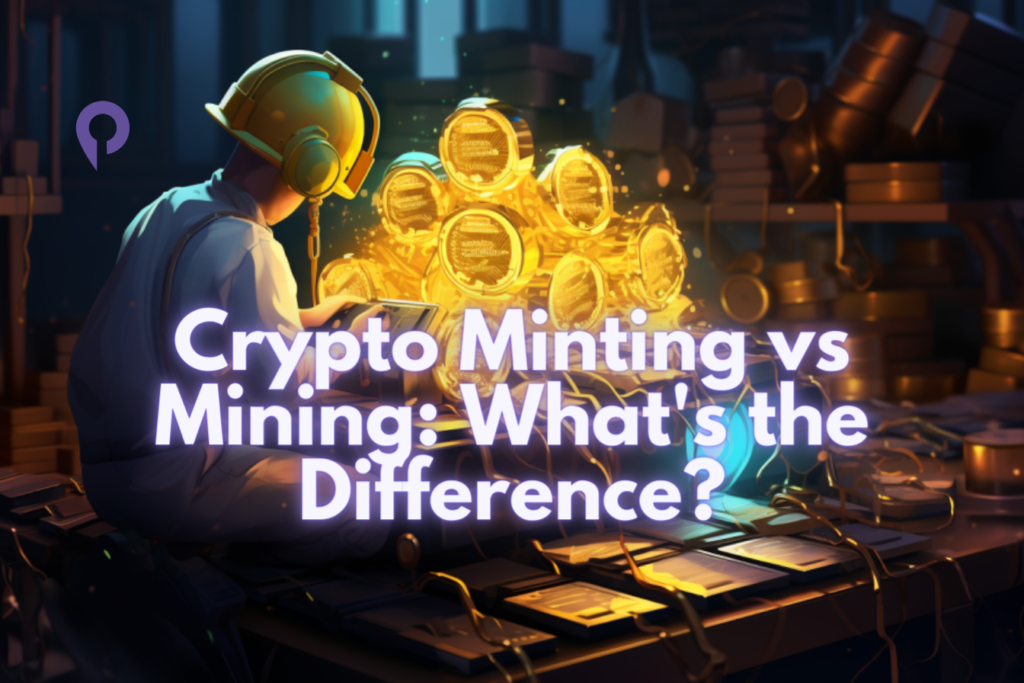Cryptocurrencies are known by the vast majority as digital tokens that can be traded on some exchanges and may be held in a wallet or portfolio for potential profit after a while. But little attention is paid to how some of these digital tokens come into existence. Cryptocurrencies have revamped our perspectives on finance and how to deal with financial systems, but again, there are still some basics in it!
The origin of mining has always been around the generation of money and its valuation – beginning with gold. Mining and minting are one of the ways cryptocurrencies are curated and deployed into their circulation supply. Mining and minting are common within crypto communities, and they look alike, but they are quite different. This article intends to deepen your knowledge about crypto mining and minting, by unveiling their disparities.
Also read: Are Your Investments Safe with Robinhood?
Crypto Mining — The Meaning
Crypto mining is not what you think. Imagining going to some underground backyard to slash in your digger, would be the joke of the century when considering the definition of crypto mining — because it’s not. Crypto mining is simply the whole series of processes involved in the validation and recording of transactions on a given blockchain through computational power. It solves a complex mathematical problem through the use of the Proof-of-Work (PoW) consensus algorithm to add new blocks on-chain.
Mining is more related to blockchains that use PoW consensus, like Bitcoin. These blockchains use mining as a computational solution to the network’s difficulty through hash rates and some special hardware (E.g. Powerful graphics processing units (GPUs) or application-specific integrated circuits (ASICs). Sequel to every mining activity, a reward system is in place for miners to get incentivised for securing the blockchain network and adding to the token supply in circulation.
Using Bitcoin as an example, in the earlier years of $BTC mining, a simple PC with a good CPU would conveniently mine tens of Bitcoin without any hassle. Over time, the mining difficulty increased as the mining activity increased with highly techy mining rigs, and the mining rewards got slashed. This contributes to the deflationary state of Bitcoin expressed via its OTC demand.
Basic Understanding of Crypto Minting
Cryptocurrency minting is simply crypto holders staking their coins to create new coins or tokens within a blockchain network. Minting is typically associated with Proof-of-Stake (PoS) consensus algorithms, where coin holders participate in the creation of new blocks and the validation of transactions. Instead of relying on computational power and energy-intensive processes like mining, minting allows users to generate new coins by staking their existing holdings.
In PoS systems, participants lock up a specific amount of cryptocurrency as collateral to become validators. Validators are responsible for confirming transactions and adding them to the blockchain. The likelihood of being chosen as a validator is proportional to the stake held by each participant. Minting rewards are distributed among validators based on their stake, incentivising them to act honestly and maintain the network’s integrity.
Ethereum was previously utilising the Proof-of-Work consensus, but switched to the PoS after “The Merge”. This led to about a 90% reduction in energy consumption, as it requires significantly less computational power compared to mining. Additionally, minting allows for a more inclusive and eco-friendly approach to cryptocurrency creation since it doesn’t heavily rely on expensive hardware like crypto mining.
Sheer Differences Between Mining and Minting
Mining is more like minting but in an easier and less costly way. The main difference between minting and mining lies in their underlying consensus algorithms and how new coins are created. Minting relies on Proof-of-Stake, where existing coin holders validate transactions by simply staking them and are rewarded accordingly. Mining, on the other hand, operates on Proof-of-Work, where miners compete to solve mathematical problems to earn new coins.
Minting is considered more energy-efficient and eco-friendly, as it doesn’t require extensive computational power and electricity consumption. It allows a broader range of participants to engage in cryptocurrency creation, as it doesn’t rely on specialised hardware. Bitcoin was made to supply tokens based on mining as rooted within its core beliefs of decentralisation unlike minting, which tends to be more centralised and possibly less secured based on expert research.
Mining, although energy-intensive, has been the dominant method of cryptocurrency creation for the well-established. It offers high security due to the computational power required, making it more resilient to potential attacks.
Frequently Asked Questions
What Are Examples of Blockchains Using Mining and Minting?
There are currently several blockchain networks like Bitcoin using mining as their consensus for token supply, network integrity, and network security. Examples include Bitcoin ($BTC), Litecoin ($TC), Monero ($XMR), and Bitcoin Cash ($BCH). Since crypto mining on a blockchain network is synonymous with PoW consensus, minting is commonly seen in cryptocurrencies that employ Proof-of-Stake consensus algorithms, such as Cardano (ADA), Polkadot (DOT), and Tezos (XTZ).
Which Is Better Mining and Minting?
There are different factors to be put into consideration when making a choice of the best between crypto mining and minting. At the top of these factors would be network security, energy efficiency plus utility, scalability, and network consensus. As this article has highlighted, crypto mining has more security (Due to the difficulty that needs to be solved), is less scalable, and consumes more energy.
With environmental concerns, decentralisation, accessibility, and security at the heart of the majority’s choice, crypto minting could be the choice, but the place of crypto mining remains solid.
How Do Mining and Minting Affect the Decentralisation of Cryptocurrencies?
Mining and minting can have different implications for decentralisation. In PoW systems, mining requires specialised hardware, which can lead to the concentration of mining power in the hands of a few powerful entities. This concentration can potentially undermine the decentralised nature of the network. Minting, on the other hand, often allows a broader range of participants to participate in the consensus process, enhancing decentralisation and reducing the influence of centralised mining pools.





